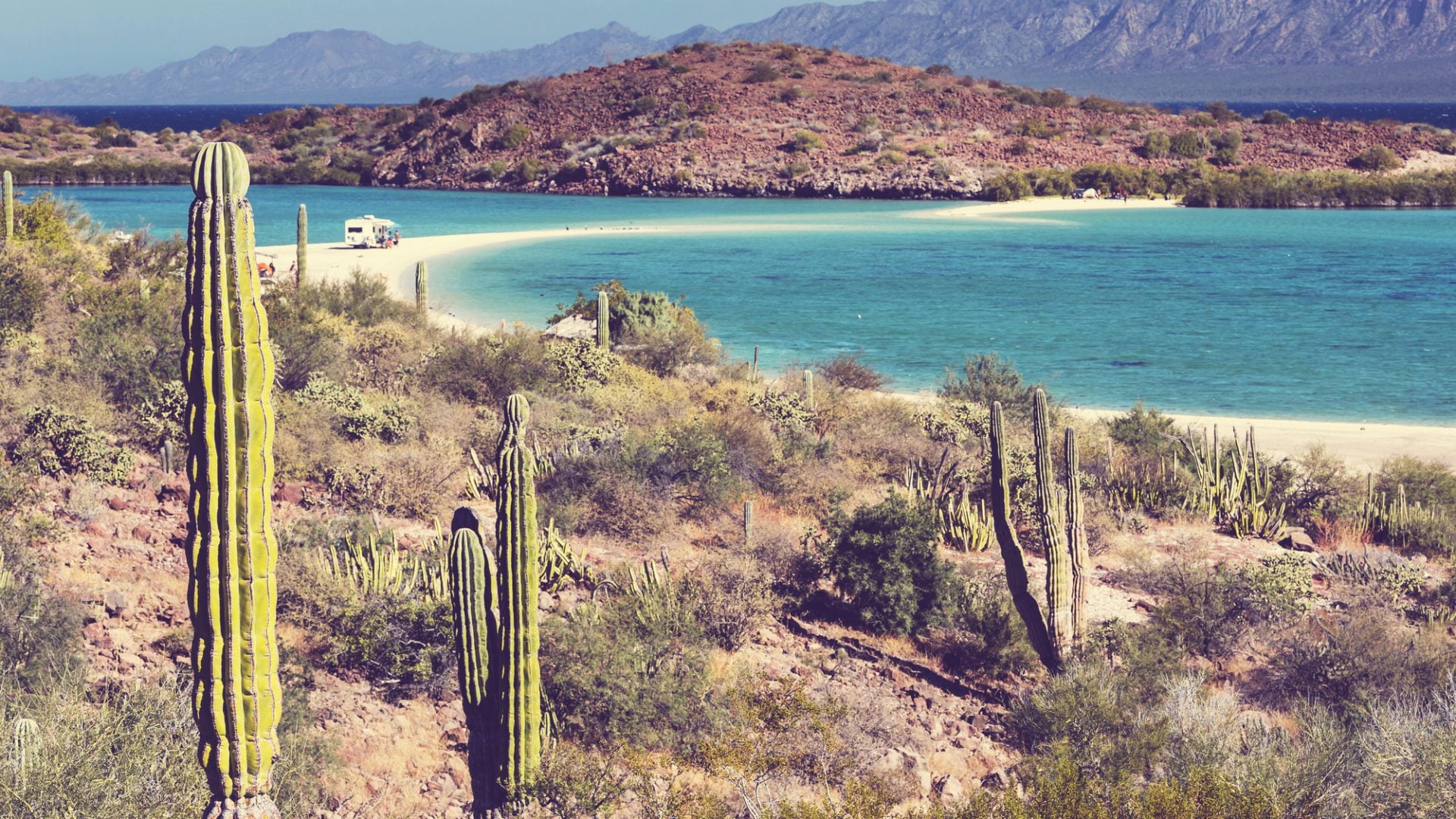Tell people you’re going cycling in Mexico and you might be met with curious looks – is that possible? Isn’t it dangerous? Won’t the roads be terrible?
But visit and you will likely fall in love with Mexico, its food, warm local hospitality – and, of course, the cycling.
That’s what happened to Joel Goralski, who moved from Calgary Alberta to Bucerias Mexico in 2013. What was supposed to be a one year “Life Experience” turned into permanent and a Mexico bike tour company. He has now clocked over 100,000 kilometres of rides in Mexico.
Here he shares his passion for cycling in Mexico.
Want to plan a Mexico cycling trip?
If you want to know the best places to ride your bike in Mexico, when to go and what to eat, read on!
Overview of Mexico (for cyclists)
Geography of Mexico
Mexico is part of Latin America, which is divided into three regions: South, Central and North America.
Mexico is sometimes mistakenly referred to as Central America but in fact is in North America. Mexico’s northern border is with the USA. Its southern borders are with Belize and Guatemala.
Mexico is home to high mountains and deep canyons, vast deserts in the north, and rain forests in the south and east.
Over half the country lies at over 1,000m elevation (great for that high altitude training camp…). The most famous mountain ranges are the Sierra Madre Occidental in the west and the Sierra Madre Oriental mountain range in the east. There are also smaller mountain ranges on the Central Plateau.
Mexico is perfect for cyclists who love to climb. From well paved roads to off the beaten track gravel and dirt, Mexico has it all.

What’s cycling in Mexico like?
Awesome. There’s a huge road network and an incredible variety of terrain that makes road cycling in Mexico a bit of a dream. And that’s before we’ve started talking about the gravel riding that’s available…
In general, cyclists are treated well and the kind of hospitality Mexico is famous for extends to cyclists too. It is pretty common for a car to pass you (in the other lane, slowly and with all the indicators flashing) with everyone yelling out the window “ánimo”. Don’t be afraid, it is kind of like you are in an episode of Star Wars and they are saying “may the force be with you!”. Local people love to see cyclists and they are always willing and ready to shout words of encouragement!
That said, like anywhere in the world, you always need to take care on the road and when riding in/around the bigger cities you need to be vigilant.
It’s also a good idea to stay off the main highways that have lots of trucks and not much shoulder. Mexico has a system of toll roads – some are perfectly acceptable to cycle on and others are not. Likewise, here are some secondary roads that are main highways and should also be avoided.
Cycling Mexico: routes and regions
Mexico is a very diverse country that allows cyclists to ride in many different ecosystems: from low to high desert, from tropical rain forest to high alpine climbs that reach in excess of 3,000 meters of elevation.
It’s got a fantastically beautiful coastline and vibrant villages which are brilliant for those of us that like some culture and food stops sprinkled into our riding.
What are the best regions of Mexico for cyclists?
A lot of bikepackers and touring cyclists go cycling through Mexico on a Trans-Mexico or Pan-Americas trip. There’s also the classic route for cycling through northern Mexico down Baja California by the Pacific before getting a boat across to the mainland.
But Mexico is also brilliant for us road cyclists that love to stay in one place and really get to know a region.
Here’s my pick of the best parts of Mexico to visit and a selection of the best routes to do while you’re there. I’ve listed them in order of preference.
1. Bucerias (Puerto Vallarta)
Bucerias and Puerto Vallarata have that kind of magic that means so many people come here for a week and end up planning their next trip before they’ve even left. Some people (like me!) don’t ever leave!
Bucerias (pronounced Boo-suh-rias) is a small beach resort on the Riviera Nayarit on Mexico’s Pacific coast. Bucerias boasts a 5 mile stretch of sandy beaches. Once a fishing village, its colourful buildings, with enormous wooden doors, and cobbled streets still exude a relaxed charm.
Bucerias lies 20 minutes north of the larger, better-known town of Puerto Vallarta. To give you an idea of the relative size of the towns, Bucerias has a population of around 17,000 residents compared with Puerto Vallarta’s 300,000.
One of the nice things about this part of Mexico’s west coast is that it’s so much less touristy and busy than more famous areas of Mexico like the Yucatán Peninsula.
What’s the cycling in Puerto Vallarta and Bucerias like?
With the Pacific Ocean on one side and the Sierra Madre mountains on the other, Bucerias and Puerto Vallarta have got diverse riding possibilities (much more so than the Yucatán Peninsula).
There is a great selection of rides for all levels. Valley flats, coastal rollers, thousands of kilometres of gravel options and the big paved climbs of the Sierra Madre. Bucerias is the number one beach destination for cyclists.
Check out our full guide to cycling Puerto Vallarta and Bucerias, including information on the best bike routes, when to visit and local tips.
 VeloGuide guests take in the views on the way to El Tuito
VeloGuide guests take in the views on the way to El Tuito Crushing Cobblestone on the climb to San Sebastian del Oeste
Crushing Cobblestone on the climb to San Sebastian del Oeste Post-ride beach and BBQ at Boca de Tomatlan
Post-ride beach and BBQ at Boca de Tomatlan
2. Mazatlán
Also on the Pacific Coast, around 450km north of Bucerias/Puerto Vallarta, Mazatlán is home to some incredible riding. It’s also home to one of the longest running gran fondos in Mexico, the Ciclo Tour Mazatlán that takes place every December.
Mazatlán is affectionately known as the Pearl of the Pacific. Its 21 kilometre boardwalk (with cycling path) is lined by sandy beaches. It’s long found favour with surfers and expats: in the 1950s it was an alluring beach destination before falling into mid-market package tourism.
More recently however, its impressive historic centre has been restored to its former colonial grandeur and has been attracting wealthy tourists once more. Its cycling credentials are also starting to get noticed.
Consider visiting around Carnival and you’ll be taking part in what’s said to be the third-largest carnival in the world, with a more family orientated feel than others. The town is also famous for its delicious seafood.
What’s the cycling like?
In terms of riding, Mazatlán was put on the map by the 2000 Mountain Biking World Cup, which was the first time the event had ever been held in Latin America. Mazatlán is also home to Perros Sin Dueño, a not for profit organisation set up to advance cycling in the town (particularly cross-country mountain biking).
However the road cycling opportunities are also excellent due to the proximity of the Sierra Madre Mountains and there are some great on-road bike shops in the town.
On top of the Malecon seafront bike path route (which is being extended currently), there are some excellent rides out to La Noria and El Recodo with little traffic, lots of climbing, beautiful scenery, and old towns.
Example Route: Mexico Ciclo Tour Mazatlán
There are two distances to choose from at this well-known gran fondo, 136km or 76km.
 Mazatlan Golden Zone, the beach resort zone
Mazatlan Golden Zone, the beach resort zone Cycling along the seafront in Mazatlán
Cycling along the seafront in Mazatlán Mazatlán’s old town
Mazatlán’s old town
3. Yucatán Peninsula
One of the country’s most famous tourist regions is the Yucatán Peninsula. This juts into the Gulf of Mexico from Mexico’s southeastern tip. The Yucatán Peninsula is famous for its beaches but also because it was once the home of the Maya civilisation, whose incredible architecture can still be visited.
There are lots of direct flights into the Yucatán due to the airport in Cancun and some of the most famous ancient cities in all of México are in Yucatán, such as Chichén Itzá, Uxmal, and Ek Balam. There are also numerous sinkholes known as cenotes, natural pools in an underground cave. They’re the perfect way to cool down when you’re not near the coast. If you’re visiting Yucatán for its beaches, culture and history, you might want to add in some cycling on the Yucatán.
What’s the cycling like?
Riding wise, it’s not the most interesting. Your routes are mostly likely to be flat, though there are a few hills in the southern part of the Peninsula. The roads are often straight, taking you through jungle and local villages. The upside is you’re likely to also pass some incredible historic sites. On the coast, the emerald green water is gorgeous and there are some nice coastal routes to try out.
I’d always choose Bucerias over Yucatán because the cycling and beaches are far better, but if you’re dead set on visiting Yucatán for the Mayan culture, get in touch and we can try and help put you in touch with a guide.
Example route: Cozumel Gran Fondo
If you like Gran Fondos, the Cozumel GF is a great choice, with a 160km or 80km loop to choose from.
The island is famous for its coral reefs and the route passes beautiful beaches and crystal clear waters. You’ll enjoy panoramic views and, if you take part in the official event, enthusiastic support from the locals.
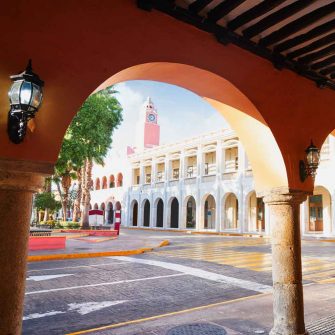 Merida city arcade arcs of Yucatan in Mexico
Merida city arcade arcs of Yucatan in Mexico Pyramid of the Sun, Mexico
Pyramid of the Sun, Mexico Cathedral of San Ildefonso in the central square Merida capital of Yucatan Mexico
Cathedral of San Ildefonso in the central square Merida capital of Yucatan Mexico4. Mexico City
Mexico City is one of the most diverse cities in the world. From cuisine to culture and architecture to history, there are lots of reasons to visit.
It wouldn’t be my first choice for a solely cycling focused trip, but if you’re there for business or other reasons, definitely consider cycling.
What’s the cycling like in Mexico city?
In recent years, and thanks to the Covid pandemic, the city has made great strides with becoming more cycling friendly and lots of new bike lanes have popped up. The cycling culture is growing despite the busy roads and hectic pace of life.
For road cyclists, the best time of the week to be in Mexico City is early on weekend mornings. At that time of day it becomes easier to find the best ways through its 573 square miles to the incredible mountains that surround it. Not every district of the city is safe however and you’ll definitely want some local help navigating the best routes. Riding in a group, whether with a guide, a local cycling club or as part of an organised gran fondo, is also a good plan.
While somewhere like Bucerias/Puerto Vallarta would provide a more relaxing cycling holiday in Mexico, if you opt for three or four days in Mexico City and a ride to Desierto Leones, they’ll forever be in your memory.
Example route: Desierto Leones
For road cyclists, the most famous cycling route in Mexico City is to climb up to Desierto Leones. It’s also very popular ride amongst locals, taking you to over 3,000 meters of elevation. If you are doing the ride during the winter months, make sure to bring layers of clothing and good gloves. It can get very cold at the top, especially if there is some rain. I recommend that you attempt on a Saturday or Sunday when there will be much less traffic.
Example route: Mexico City Epic
Wake up early and drive West to Toluca.
From there you can follow the CDMX Giro d’italia Route.
This is truly a majestic and epic ride that will take you over two large all category climbs to elevation over 3,000 meters.
Do all of these regions cater to beginner cyclists?
All levels can be accommodated in Mexico in a destination like Bucerias.
For those looking for riding in Mexico City, due to the city nature of the riding there, we recommend those who are experienced cyclists with at least three years of riding experience.
Cycling events in Mexico
There are a growing number of amateur cycling events taking place in Mexico. From local gran fondos, to world class events where cyclists can take on majestic alpine climbs. Examples include:
Baja Bike Race
A gran fondo that takes you from Tecate to Ensenada in the northern Baja region of the country.
L’Etape Estado de Mexico
A very tough closed road route launched in 2019 by Alberto Contador. Each of the three routes sits at 2,000 to 2,800m above sea level.
Haute Route Mexico
Held in the pine forests around the Valle de Bravo, in 2020 this was a three day event, in 2021 it’s back as a one day event.
Mexico Ciclo Tour Mazatlán
More details above.
 Past Gran Fondo Riviera Nayarit (Valley Roads)
Past Gran Fondo Riviera Nayarit (Valley Roads) Cycling through Mazatlán
Cycling through Mazatlán Local Cycling Race in La Cruz de Huanacaxtle
Local Cycling Race in La Cruz de Huanacaxtle Where to stay in Mexico (for road cyclists)
Below I suggest some of the best places to stay in each of the towns/regions I’ve recommended above. Exact accommodation will always come down to your budget, who you’re travelling with and whether you’re looking for a hotel or more of a villa-style accommodation.
1. Bucerias (Puerto Vallarta)
I own and operate MaraVilla in Bucerias and would love to have you come and stay with us. There’s more information in our guide to cycling in Bucerias.
2. Mazatlán
Zona Dorada is the most central area in Mazatlán. It’s near the beach, within walking distance to restaurants and has got easy exits for cycling.
Cerritos is a little further from Zona Dorada, but it’s closer to the quieter roads and it’s nice because the marina is around there.
Finally, Playa del Sur would be a good option too. It’s a neighborhood that’s closer to the historic Mazatlán downtown. Casa Lucila is a nice boutique hotel that is also bike-friendly.
3. Mexico City
I recommend Polanco, Mexico City’s most exclusive neighbourhood, where you’ll find fine dining (including several Michelin-starred restaurants), designer boutiques, and the city’s biggest concentration of 5-star hotels.
For those looking to do more of a traditional feel, we recommend Roma and La Condesa.
4. Yucatán Peninsula
Merida is one of the prettiest colonial cities in Mexico and a foodie paradise. Valladolid is the Yucatán’s third largest city with a comfortable charm about it, nice sights and easy access to the Mayan site of Ek Balam. You can also visit several cenotes (underground sinkholes) from here. These two towns would make good bases in the inland areas of the Yucatán Peninsula.
On the coast, Cozumel is a great option. Playa del Carmen and Tulum are well-known but are very touristy.
Bike hire + bike shops
Bike hire in Mexico
The bike rental scene is just starting to grow in Mexico, but is currently quite limited for road bikes.
If you’re staying in Puerto Vallarta/Bucerias, come and chat with me and my team at Bici Bucerias.
Bike shops in Mexico
There are loads of bike shops throughout Mexico; in any mid-sized town you will be able to find a bike shop selling decent quality parts.
If you get a flat while you’re out on the road, it’s worth knowing there are ferreteria’s (hardware stores) in most towns and they sell inner tubes.
 Phil Gaimon and local VeloGuides at Fortuna de Vallejo
Phil Gaimon and local VeloGuides at Fortuna de Vallejo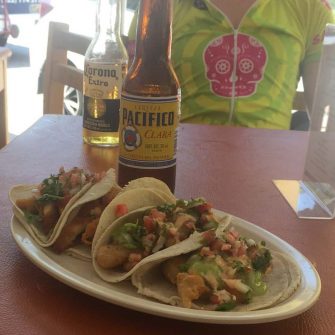 Post-ride fish tacos and a couple cold beers
Post-ride fish tacos and a couple cold beers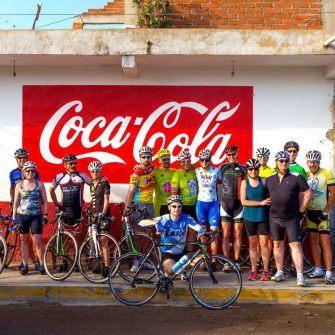 Refuelling at a local tienda (store) in San Juan de Abajo
Refuelling at a local tienda (store) in San Juan de AbajoWhen to visit Mexico
The best time to come to Mexico’s beach areas are between mid November and early April. This is when you still have cool evenings and mornings along with nice warm days. It makes for a perfect set up to ride early and then spend time with family and friends on the beach or poolside during the day. However, be aware that winter months in Mexico City (or any central Mexico area in the high mountains) can be cold with morning temperatures at or below freezing.
The summer months (June through to September) are generally the rainy season and there could be days where you get rained out. That being said, the rain at the beach is usually warmer and provided it is not a downpour, it is rideable.
The summer and early Autumn are also best avoided if you’re worried about hurricane season in Mexico, which starts in June and runs until the end of November. The highest risk of hurricanes falls between August and October.
General tips for biking in Mexico
Is it safe to visit?
I’ve lived in Mexico since 2013 and in my experience, contrary to popular mainstream media opinion, Mexico is a very safe country to visit. From a cycling perspective cyclists enjoy courteous motorists who are generally happy to see them (it is not uncommon for passing motorists to shout words of encouragement and give thumbs up to cyclists when passing!).
In Mexico, the main crime (and what the country gets its adverse reputation for) is drug running, but if you stay away from that, you’re unlikely to have a problem.
By all means, check government advice for hotspots to avoid before you go and avoid wandering in dodgy areas after dark – but don’t avoid Mexico altogether. You’ll be missing out!
Books
There are several books about cycling the Pacific Coast from Canada to Mexico aimed at bikepackers.
You might also find inspiration in Epic Bike Rides of the Americas by Lonely Planet.
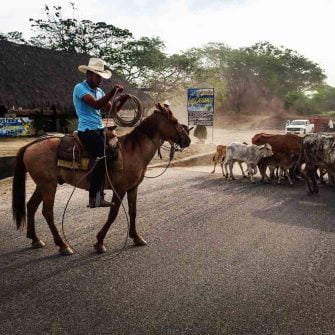 Local Vaqueros (Cowboys) along popular cycling route by el Colomo
Local Vaqueros (Cowboys) along popular cycling route by el Colomo Taking a beach break from bike at beautiful Playa Destiladeras
Taking a beach break from bike at beautiful Playa Destiladeras  Always a cold beer around any corner of Mexico
Always a cold beer around any corner of Mexico
Rules of the road in Mexico
Get familiar with Mexico’s road signs and rules of the road before you go.
A few tips for cyclists:
- Two abreast is generally fine.
- The cyclist has the right of way when traffic approaches from behind.
- Don’t be scared to take up your lane; we recommend connecting with drivers via hand signals, i.e. letting them know to wait or waiving them through to pass.
- Stop signs are labelled “Alto” but watch out for the fact that there aren’t lines painted on the roads to mark where to stop.
- Watch out for the speed bumps! Sometimes they’re painted, sometimes they’re not, but they are in almost every town and can easily catch you out if you’re not expecting them.
Food to try
The Mexican food scene is incredible. From Michelin rated restaurants to street tacos and everything in between. Take it all in! The street food, the fresh juices. It is all very safe to eat and delicious. (Just be aware that the tap water is not drinkable.)
Check out this YouTube channel for some incredible videos that will give you a first hand look at the local food scene.
In terms of resupplying while you’re out on a long ride, of course always ride prepared with emergency water and snacks. However, the great thing about Mexico is that there is always a store in every little town no matter how small it is. There are also many little towns. You can usually get away with two bottles at the most and just restocking, and supporting the local economy, in the towns you pass through.
Do you need to speak Spanish?
It’s definitely not required, but it could be helpful in rural areas
Mexico is hugely popular with cyclists in America, wanting to experience some Latin flair not too far from home. This means that in the areas where the locals are used to tourists, you shouldn’t have a problem with your few words of Spanish. Get off the beaten track and you might have to resort to more sign language to make yourself understood!
How to get to Mexico?
There are easy flights to various locations, including Mexico City, San Jose del Cabo and Guadalajara, from many US and Canadian cities.
Likewise, there are flights from London, Birmingham and Manchester to Mexico – either Mexico City or Cancun. There once was even a daily flight from Manchester to Puerto Vallarta. We hope that starts up again!
Final tips
A small point, but you might notice that Mexicans often start their conversation with a friendly greeting like good morning, good afternoon or good evening. It’s considered impolite to just reply with what you want, so if you want to respect their culture, return their greeting before making your request!
Credit/debit cards are often accepted, but it’s still useful to have cash, especially when you’re out of the main towns. Many places will accept US dollars, but it’s sensible to have pesos.
Want to head further south? How about Uruguay? Or Chile?
Please support Epic Road Rides
A huge amount of time and effort goes into the article you’ve just read, all with the aim of helping you!
If you found what you’ve read useful, I’d really appreciate it if you dropped something in the tip jar here.
It’s a way you can say thank you and help us carry on creating top quality content with no annoying ads and no pay wall.
Looking for an organised cycling trip?
If you want someone to help you plan and book your cycling holiday, fill out this form. We aren’t a tour operator/agent but we work with lots of people who are and will do our best to put you in touch with someone that can help (within 24 hours where possible)!The contents of this website are provided for general information purposes only. It is not intended to amount to advice and you should not rely on it. You should carry out your own due diligence and risk assessments and take professional advice. Views expressed by interviewees or other users of this website do not necessarily represent our views. We make no representations, warranties or guarantees, whether express or implied, that the content on our website is accurate, complete or up to date. If you use any information or content on this website, download from, or otherwise obtain content or services through our website, it is entirely at your own discretion and risk. Epic Road Rides Ltd disclaims all liability and responsibility arising from any reliance placed on the information and content on this website. Find out more here.

